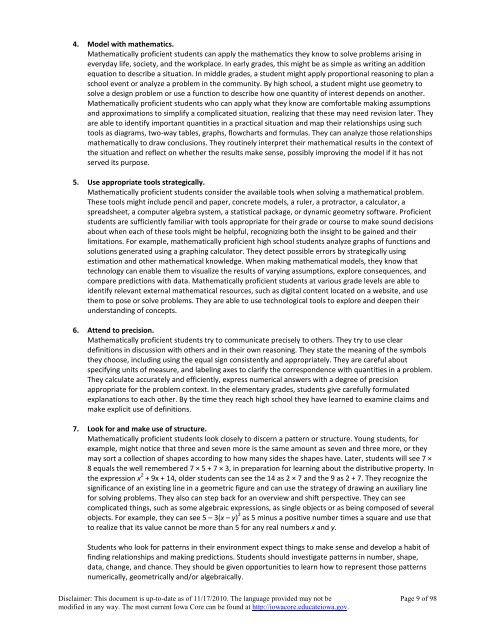Iowa Core K-12 Mathematics (PDF) - Green Hills AEA
Iowa Core K-12 Mathematics (PDF) - Green Hills AEA
Iowa Core K-12 Mathematics (PDF) - Green Hills AEA
Create successful ePaper yourself
Turn your PDF publications into a flip-book with our unique Google optimized e-Paper software.
4. Model with mathematics.<br />
Mathematically proficient students can apply the mathematics they know to solve problems arising in<br />
everyday life, society, and the workplace. In early grades, this might be as simple as writing an addition<br />
equation to describe a situation. In middle grades, a student might apply proportional reasoning to plan a<br />
school event or analyze a problem in the community. By high school, a student might use geometry to<br />
solve a design problem or use a function to describe how one quantity of interest depends on another.<br />
Mathematically proficient students who can apply what they know are comfortable making assumptions<br />
and approximations to simplify a complicated situation, realizing that these may need revision later. They<br />
are able to identify important quantities in a practical situation and map their relationships using such<br />
tools as diagrams, two-way tables, graphs, flowcharts and formulas. They can analyze those relationships<br />
mathematically to draw conclusions. They routinely interpret their mathematical results in the context of<br />
the situation and reflect on whether the results make sense, possibly improving the model if it has not<br />
served its purpose.<br />
5. Use appropriate tools strategically.<br />
Mathematically proficient students consider the available tools when solving a mathematical problem.<br />
These tools might include pencil and paper, concrete models, a ruler, a protractor, a calculator, a<br />
spreadsheet, a computer algebra system, a statistical package, or dynamic geometry software. Proficient<br />
students are sufficiently familiar with tools appropriate for their grade or course to make sound decisions<br />
about when each of these tools might be helpful, recognizing both the insight to be gained and their<br />
limitations. For example, mathematically proficient high school students analyze graphs of functions and<br />
solutions generated using a graphing calculator. They detect possible errors by strategically using<br />
estimation and other mathematical knowledge. When making mathematical models, they know that<br />
technology can enable them to visualize the results of varying assumptions, explore consequences, and<br />
compare predictions with data. Mathematically proficient students at various grade levels are able to<br />
identify relevant external mathematical resources, such as digital content located on a website, and use<br />
them to pose or solve problems. They are able to use technological tools to explore and deepen their<br />
understanding of concepts.<br />
6. Attend to precision.<br />
Mathematically proficient students try to communicate precisely to others. They try to use clear<br />
definitions in discussion with others and in their own reasoning. They state the meaning of the symbols<br />
they choose, including using the equal sign consistently and appropriately. They are careful about<br />
specifying units of measure, and labeling axes to clarify the correspondence with quantities in a problem.<br />
They calculate accurately and efficiently, express numerical answers with a degree of precision<br />
appropriate for the problem context. In the elementary grades, students give carefully formulated<br />
explanations to each other. By the time they reach high school they have learned to examine claims and<br />
make explicit use of definitions.<br />
7. Look for and make use of structure.<br />
Mathematically proficient students look closely to discern a pattern or structure. Young students, for<br />
example, might notice that three and seven more is the same amount as seven and three more, or they<br />
may sort a collection of shapes according to how many sides the shapes have. Later, students will see 7 ×<br />
8 equals the well remembered 7 × 5 + 7 × 3, in preparation for learning about the distributive property. In<br />
the expression x 2 + 9x + 14, older students can see the 14 as 2 × 7 and the 9 as 2 + 7. They recognize the<br />
significance of an existing line in a geometric figure and can use the strategy of drawing an auxiliary line<br />
for solving problems. They also can step back for an overview and shift perspective. They can see<br />
complicated things, such as some algebraic expressions, as single objects or as being composed of several<br />
objects. For example, they can see 5 – 3(x – y) 2 as 5 minus a positive number times a square and use that<br />
to realize that its value cannot be more than 5 for any real numbers x and y.<br />
Students who look for patterns in their environment expect things to make sense and develop a habit of<br />
finding relationships and making predictions. Students should investigate patterns in number, shape,<br />
data, change, and chance. They should be given opportunities to learn how to represent those patterns<br />
numerically, geometrically and/or algebraically.<br />
Disclaimer: This document is up-to-date as of 11/17/2010. The language provided may not be Page 9 of 98<br />
modified in any way. The most current <strong>Iowa</strong> <strong>Core</strong> can be found at http://iowacore.educateiowa.gov.
















